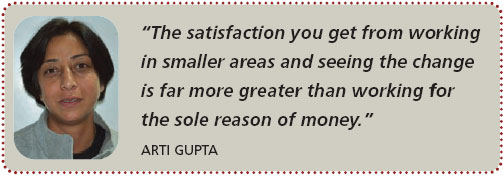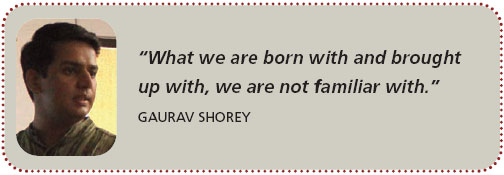The offroadersBy: ARISTO MENDIS & JESSICA LUIS
If you ever thought that careers in environment were only about wearing lab coats, clockwork routines and 'petri dish'
jobs, then consider to reconsider. Meet three dynamic personalities, who have taken up seemingly usual fields and
turned them on upside down to prove that green jobs can also be a fun-filled enthralling experience.
 ARTI GUPTA
English Scholar turned Wilderness
Explorer
ARTI GUPTA
English Scholar turned Wilderness
Explorer
I work in a venture called
Mountain Cruize. For the last
sixteen years I've also been into
environmental education and was
a resource person for organizations
like TERI and WWF. I quit my job
with UNDP in Delhi and returned
to Himachal Pradesh.
Initially after graduating in
English literature I was going to be
a teacher, but my love for
adventure and wilderness led me
to do this and I never looked back
ever since.
What activities are included in your
camps?
We organize various types of
camps. We also do something
called 'Leave No Trace' activities in
our camps, which run on the
principle of leaving minimum
impact behind on the environment.
We give teams rations of food and
other camping essentials which
they have to make do with till they
trek to the destination. These
camps give a firsthand kind of
learning experience, and teach
team-building over even simple
exercises like building a campfire.
What's been the highest point of
your career so far?
I've been able to give my son and
the rest of the family time and also
focus on my work. Gradually we
dream of making this venture into
an adventure institute in the
future. That, in my opinion will be
a high point for sure.
What's your advice to other budding
aspirants?
Firstly, choose the specific area of
interest and then learn more
about it. Another thing that helps
is to explore the place where you
finally want to be based in
future.

GAURAV SHOREY
The Sustainability Guru
I work with an NGO called 5waraj
(Swaraj) whose aim is passing on
traditional knowledge and
sustainable living in the Indian
context. The five components that
we absolutely need for
sustainability that we work on
are Bhasha (Dialect), Vesh
(Dress), Bhajan (Dance & Music),
Bhojan (Diet) and Bhavan
(Dwellings).
What were you doing before you
came up with this project?
I am by qualification, an architect.
I was working as a green buildings
consultant in an organization
called The Energy and Resources
Institute (TERI). The idea for
5waraj came up when I was doing
my research in Delhi on national
level policies on how to make
buildings green in India. It lead me
to realize that the answer is not
only in addressing only water, or
only buildings independently; the
answer lies in addressing all these
five components simultaneously.
We needed to look within instead
of outside, we want to blindly ape
developed nations to catch up with
them, but is it logically possible?
It's important that we don't
disconnect with our traditional
knowledge in the process.
What are the activities that you
carry out?
For now, we do workshops in
schools and colleges and even for
working professionals in cities like
Mumbai, Delhi, Chennai and
Bangalore. Our aim is to make
people realize that the language
that they have been brought up
speaking, the clothes that they
wear, and the food that they have
been brought up eating is what
makes them what they are. One
fun activity we do in our
workshops for instance, is giving
participants a three meter long
cloth and telling them to design
attire for another climate zone of
the country without cutting the
cloth but using knots and pleats.
In the long run, 5waraj can
ARISTO MENDIS & JESSICA LUIS
If you ever thought that careers in environment were only about wearing lab coats, clockwork routines and 'petri dish'
jobs, then consider to reconsider. Meet three dynamic personalities, who have taken up seemingly usual fields and
turned them on upside down to prove that green jobs can also be a fun-filled enthralling experience.
"The satisfaction you get from working
in smaller areas and seeing the change
is far more greater than working for
the sole reason of money."
ARTI GUPTA
only thrive by us going into the
heartland of rural India and
collecting information from them.
Our long term aim is to reverse the
trend of people leaving their
villages and coming to cities by
making them realize that what
they are sitting on is a goldmine.
How do you link these goldmines of
traditional knowledge to the urban
crowd?
The key lies in languages. For
instance, the Khasi dialect of
Shillong has thirty words for rain
alone, for different forms of rain
like sleet, hail, and drizzle, flood
level rain and so on. The problem
is that in most states in India,
what's being forwarded is either
English or Hindi, which is entirely
killing off dialects. Now what's
interesting to note over here is that
if you look at any developed
country, they are very proud of
speaking their mother tongue. And
countries like France and Germany
want us to learn their language.
Why don't we have a similar
mindset?
One of our intentions is
to open a school on languages, so
if instead of say, French, someone
wants to learn Khasi, or even
Rajasthani or Haryani bolvis, they
can just hop in and take a summer
school lesson. We're looking at
something that doesn't require
heavy infrastructure or libraries. I
only need one local person who
speaks that language and can
teach it to others.
You advice to people who want to
strike out and do something like this?
You should be in love with what
you're doing, not in love with why
you're doing it. A lot of people are
in love with the reason why they're
doing something, "I'll get a lot of
money", or "I'll get to go abroad",
or "My parents will be impressed",
is what one usually hears.
So you can get that kind of
insight when you fall in love with
what you do. It allows you to give a
rat's ass about what the world
thinks you're doing.

Dr. VANEET JISHTU
Adrenaline Junkie Botanist
I am a scientist working with the
Himalayan Forest Research
Institute, Shimla. I work as a field
botanist and taxonomist in the
cold deserts and forests of
Himalayas. I am also currently
working on the viability of an
arboretum that's to be based near
Shimla which will include about
150 native species from the region
which will help the public get a
look at the rich biodiversity of the
Himalayan landscape.
How did you get into this field?
I had always loved the wilderness;
trekking and photographing wild
flowers. At a crucial point in my
career came along Dr. G.S. Goraya
who observed my interest towards
plants and encouraged me to do
more towards the taxonomy and
identification of plants. I started
going for field trips with him and
other reputed botanists, which
included scribbling down notes
about plants and their descriptions
and coming back to study the flora
in depth. Now we can identify
almost ninety-five percent of plants
just by looking at them, all thanks
to the extensive field visits.
What's been the high point of your
career so far?
The high point of my career came
around 15 years ago when I was
nominated as a member of the
"Multidisciplinary Committee to
Monitor Environmental
Safeguards" of the Baspa HEP- II
dam of JP Industries.
What's your advice to other budding
aspirants?
These days, parents lead their
children in the well-towed line of
civil services, doctors, engin/eers
and so on. However, my advice to
the younger lot would be to
venture into unorthodox careers,
which are more challenging and
personally satisfying. If in any case
you want to work in the
environmental field, I personally
recommend "Taxonomy". This is
one field where there is hardly any
competition, and off late there is a
great demand for good
taxonomists; because this
subject is the basis of any
environmental activity, both
faunal and floral.
